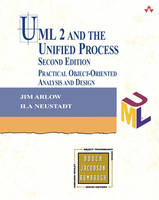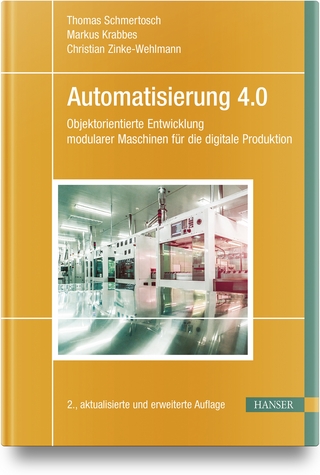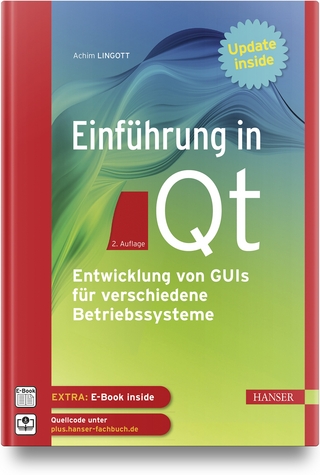
UML 2 and the Unified Process
Addison-Wesley Educational Publishers Inc (Verlag)
978-0-321-32127-5 (ISBN)
- Titel ist leider vergriffen;
keine Neuauflage - Artikel merken
"This book manages to convey the practical use of UML 2 in clear and understandable terms with many examples and guidelines. Even for people not working with the Unified Process, the book is still of great use. UML 2 and the Unified Process, Second Edition is a must-read for every UML 2 beginner and a helpful guide and reference for the experienced practitioner."
--Roland Leibundgut, Technical Director, Zuehlke Engineering Ltd.
"This book is a good starting point for organizations and individuals who are adopting UP and need to understand how to provide visualization of the different aspects needed to satisfy it. "
--Eric Naiburg, Market Manager, Desktop Products, IBM Rational Software
This thoroughly revised edition provides an indispensable and practical guide to the complex process of object-oriented analysis and design using UML 2. It describes how the process of OO analysis and design fits into the software development lifecycle as defined by the Unified Process (UP).
UML 2 and the Unified Process contains a wealth of practical, powerful, and useful techniques that you can apply immediately. As you progress through the text, you will learn OO analysis and design techniques, UML syntax and semantics, and the relevant aspects of the UP. The book provides you with an accurate and succinct summary of both UML and UP from the point of view of the OO analyst and designer.
This book provides
Chapter roadmaps, detailed diagrams, and margin notes allowing you to focus on your needs
Outline summaries for each chapter, making it ideal for revision, and a comprehensive index that can be used as a reference
New to this edition:
Completely revised and updated for UML 2 syntax
Easy to understand explanations of the new UML 2 semantics
More real-world examples
A new section on the Object Constraint Language (OCL)
Introductory material on the OMG's Model Driven Architecture (MDA)
The accompanying website provides
A complete example of a simple e-commerce system
Open source tools for requirements engineering and use case modeling
Industrial-strength UML course materials based on the book
Jim Arlow has been programming and designing object-oriented software systems since 1990. He has created object models for blue chip companies such as British Airways and M&G. He is a respected OO consultant in Europe and has written and delivered many training courses on object technology and Java. Jim is a regular speaker at conferences such as Object World, and has been an invited speaker at University College London, City University, and the British Computer Society. Ila Neustadt has worked in IT for British Airways for more than twenty years and has experience of all parts within the IT development life cycle. She worked in the strategy department modeling the architecture process and developing architecture training, and acted as program head for the graduate business analyst program. Ila now coordinates skills development for BAs IT staff.
Acknowledgments.
Preface.
I. INTRODUCING UML AND UP.
1. What is UML?
1.1 Chapter roadmap
1.2 What is UML?
1.3 The birth of UML
1.4 MDA - the future of UML
1.5 Why "unified"?
1.6 Objects and UML
1.7 UML structure
1.8 UML building blocks
1.9 UML common mechanisms
1.10 Architecture
1.11 What we have learned
2. What is the Unified Process?
2.1 Chapter roadmap
2.2 What is UP?
2.3 The birth of UP
2.4 UP and the Rational Unified Process
2.5 Instantiating UP for your project
2.6 UP axioms
2.7 UP is an iterative and incremental process
2.8 UP structure
2.9 UP phases
2.10 What we have learned
II. REQUIREMENTS.
3. The requirements workflow.
3.1 Chapter roadmap
3.2 The requirements workflow
3.3 Software requirements - metamodel
3.4 Requirements workflow detail
3.5 The importance of requirements
3.6 Defining requirements
3.7 Finding requirements
3.8 What we have learned
4. Use case modeling.
4.1 Chapter roadmap
4.2 Use case modeling
4.3 UP activity: Find actors and use cases
4.4 UP activity: Detail a use case
4.5 Use case specification
4.6 Requirements tracing
4.7 When to apply use case modeling
4.8 What we have learned
5. Advanced use case modeling.
5.1 Chapter roadmap
5.2 Actor generalization
5.3 Use case generalization
5.4 "include"
5.5 "extend"
5.6 When to use advanced features
5.7 Hints and tips for writing use cases
5.8 What we have learned
III. ANALYSIS.
6. The analysis workflow.
6.1 Chapter roadmap
6.2 The analysis workflow
6.3 Analysis artifacts - metamodel
6.4 Analysis workflow detail
6.5 Analysis model - rules of thumb
6.6 What we have learned
7. Objects and classes.
7.1 Chapter roadmap
7.2 What are objects?
7.3 UML object notation
7.4 What are classes?
7.5 UML class notation
7.6 Scope
7.7 Object construction and destruction
7.8 What we have learned
8. Finding analysis classes.
8.1 Chapter roadmap
8.2 UP activity: Analyze a use case
8.3 What are analysis classes?
8.4 Finding classes
8.5 Creating a first-cut analysis model
8.6 What we have learned
9. Relationships.
9.1 Chapter roadmap
9.2 What is a relationship?
9.3 What is a link?
9.4 What is an association?
9.5 What is a dependency?
9.6 What we have learned
10. Inheritance and polymorphism.
10.1 Chapter roadmap
10.2 Generalization
10.3 Class inheritance
10.4 Polymorphism
10.5 Advanced generalization
10.6 What we have learned
11. Analysis packages.
11.1 Chapter roadmap
11.2 What is a package?
11.3 Packages and namespaces
11.4 Nested packages
11.5 Package dependencies
11.6 Package generalization
11.7 Architectural analysis
11.8 What we have learned
12. Use case realization.
12.1 Chapter roadmap
12.2 UP activity: Analyze a use case
12.3 What are use case realizations?
12.4 Use case realization - elements
12.5 Interactions
12.6 Lifelines
12.7 Messages
12.8 Interaction diagrams
12.9 Sequence diagrams
12.10 Combined fragments and operators
12.11 Communication diagrams
12.12 What we have learned
13. Advanced use case realization.
13.1 Chapter roadmap
13.2 Interaction occurrences
13.3 Continuations
13.4 What we have learned
14. Activity diagrams.
14.1 Chapter roadmap
14.2 What are activity diagrams?
14.3 Activity diagrams and the UP
14.4 Activities
14.5 Activity semantics
14.6 Activity partitions
14.7 Action nodes
14.8 Control nodes
14.9 Object nodes
14.10 Pins
14.11 What we have learned
15. Advanced activity diagrams.
15.1 Chapter roadmap
15.2 Connectors
15.3 Interruptible activity regions
15.4 Exception handling
15.5 Expansion nodes
15.6 Sending signals and accepting events
15.7 Streaming
15.8 Advanced object flow features
15.9 Multicast and multireceive
15.10 Parameter sets
15.11 "centralBuffer" node
15.12 Interaction overview diagrams
15.13 What we have learned
IV. DESIGN.
16. The design workflow.
16.1 Chapter roadmap
16.2 The design workflow
16.3 Design artifacts - metamodel
16.4 Design workflow detail
16.5 UP activity: Architectural design
16.6 What we have learned
17. Design classes.
17.1 Chapter roadmap
17.2 UP activity: Design a class
17.3 What are design classes?
17.4 Anatomy of a design class
17.5 Well-formed design classes
17.6 Inheritance
17.7 Templates
17.8 Nested classes
17.9 What we have learned
18. Refining analysis relationships.
18.1 Chapter roadmap
18.2 Design relationships
18.3 Aggregation and composition
18.4 Aggregation semantics
18.5 Composition semantics
18.6 How to refine analysis relationships
18.7 One-to-one associations
18.8 Many-to-one associations
18.9 One-to-many associations
18.10 Collections
18.11 Reified relationships
18.12 Exploring composition with structured classes
18.13 What we have learned
19. Interfaces and components.
19.1 Chapter roadmap
19.2 UP activity: Design a subsystem
19.3 What is an interface?
19.4 Provided and required interfaces
19.5 Interface realization vs. inheritance
19.6 Ports
19.7 Interfaces and component-based development
19.8 What is a component?
19.9 Component stereotypes
19.10 Subsystems
19.11 Finding interfaces
19.12 Designing with interfaces
19.13 Advantages and disadvantages of interfaces
19.14 What we have learned
20. Use case realization-design.
20.1 Chapter roadmap
20.2 UP activity: Design a use case
20.3 Use case realization-design
20.4 Interaction diagrams in design
20.5 Modeling concurrency
20.6 Subsystem interactions
20.7 Timing diagrams
20.8 Example of use case realization-design
20.9 What we have learned
21. State machines.
21.1 Chapter roadmap
21.2 State machines
21.3 State machines and the UP
21.4 State machine diagrams
21.5 States
21.6 Transitions
21.7 Events
21.8 What we have learned
22. Advanced state machines.
22.1 Chapter roadmap
22.2 Composite states
22.3 Submachine states
22.4 Submachine communication
22.5 History
22.6 What we have learned
V. IMPLEMENTATION.
23. The implementation workflow.
23.1 Chapter roadmap
23.2 The implementation workflow
23.3 Implementation artifacts - metamodel
23.4 Implementation workflow detail
23.5 Artifacts
23.6 What we have learned
24. Deployment.
24.1 Chapter roadmap
24.2 UP activity: Architectural implementation
24.3 The deployment diagram
24.4 Nodes
24.5 Artifacts
24.6 Deployment
24.7 What we have learned
VI. SUPPLEMENTARY MATERIAL.
25. Introduction to OCL.
25.1 Chapter roadmap
25.2 What is the Object Constraint Language (OCL)?
25.3 Why use OCL?
25.4 OCL expression syntax
25.5 Package context and pathnames
25.6 The expression context
25.7 Types of OCL expressions
25.8 The expression body
25.9 OCL navigation
25.10 Types of OCL expression in detail
25.11 OCL in other types of diagrams
25.12 Advanced topics
25.13 What we have learned
Appendix 1: Example use case model.
Appendix 2: XML and use cases.
Bibliography.
Index.
| Erscheint lt. Verlag | 14.7.2005 |
|---|---|
| Reihe/Serie | The Addison-Wesley Object Technology Series |
| Verlagsort | New Jersey |
| Sprache | englisch |
| Maße | 189 x 236 mm |
| Gewicht | 1059 g |
| Themenwelt | Informatik ► Software Entwicklung ► Objektorientierung |
| ISBN-10 | 0-321-32127-8 / 0321321278 |
| ISBN-13 | 978-0-321-32127-5 / 9780321321275 |
| Zustand | Neuware |
| Informationen gemäß Produktsicherheitsverordnung (GPSR) | |
| Haben Sie eine Frage zum Produkt? |
aus dem Bereich


